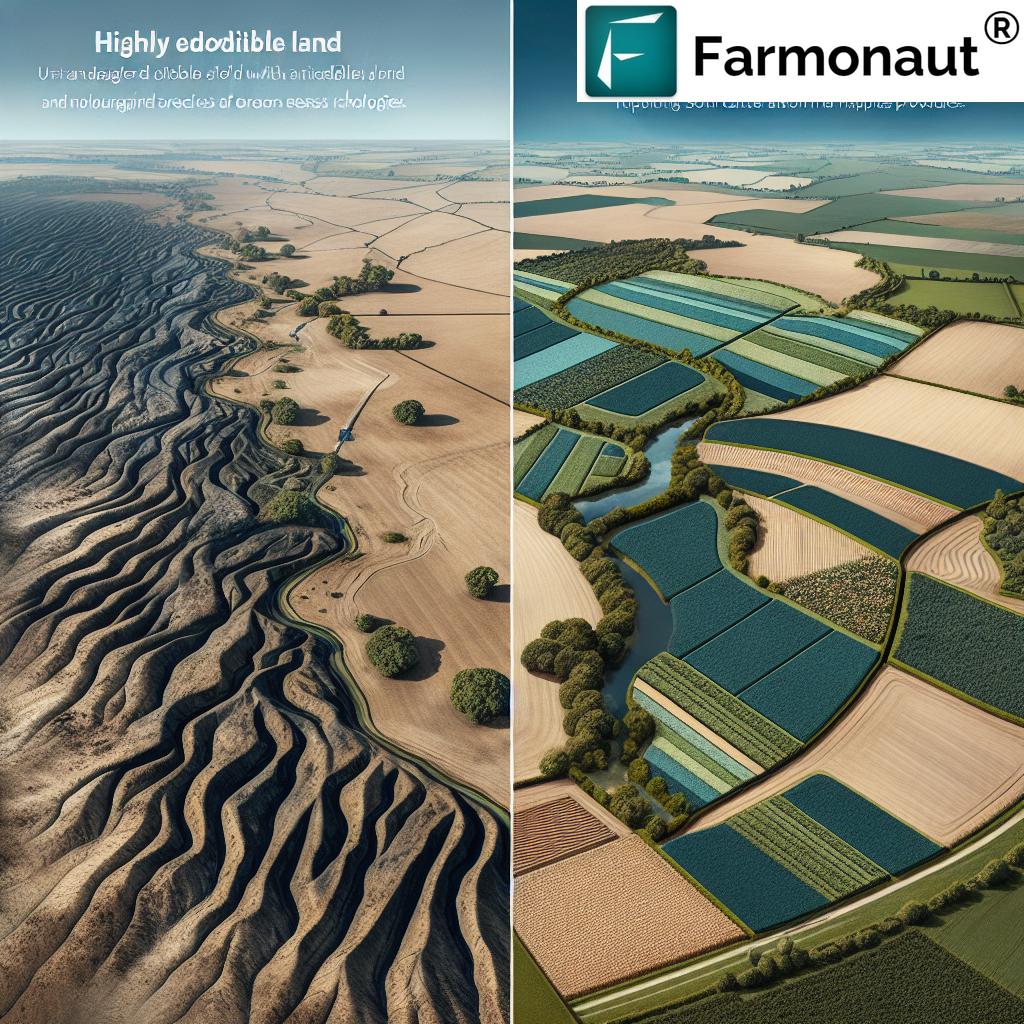Mastering Conservation Compliance: Essential Soil Erosion Prevention Strategies for Highly Erodible Land
“Over 100 million acres of U.S. cropland are classified as highly erodible, requiring specific conservation measures for USDA program eligibility.”
Welcome to our comprehensive guide on conservation compliance for highly erodible land. As stewards of the earth, we at Farmonaut understand the crucial role that soil erosion prevention plays in sustainable agricultural practices. In this blog post, we’ll explore the essential strategies and USDA conservation programs designed to protect and manage erodible farmland, ensuring both environmental preservation and agricultural productivity.

Understanding Conservation Compliance for Highly Erodible Land
Conservation compliance is a cornerstone of sustainable farming practices, particularly when it comes to managing highly erodible land. Farmers cultivating sensitive areas must implement approved conservation plans to maintain program eligibility and preserve our natural resources. Let’s delve into the key aspects of this critical agricultural management approach.
What is Highly Erodible Land?
Highly erodible land (HEL) refers to areas that are susceptible to excessive soil loss due to wind or water erosion. These landscapes require special attention and management to prevent degradation and maintain their productive capacity. Identifying and properly managing HEL is essential for both environmental protection and long-term agricultural viability.
The Importance of Conservation Compliance
Conservation compliance is not just a regulatory requirement; it’s a commitment to sustainable land management. By adhering to conservation plans, farmers can:
- Protect soil health and structure
- Maintain or improve water quality
- Preserve wildlife habitats
- Ensure long-term farm productivity
- Qualify for USDA program benefits
At Farmonaut, we recognize the challenges farmers face in implementing effective conservation strategies. That’s why we’ve developed advanced remote sensing technology to support your conservation efforts and improve farm management practices. Our satellite-based crop health monitoring system can help you identify areas at risk of erosion and track the effectiveness of your conservation measures.
Explore our advanced farm management solutions:
USDA Conservation Programs for Highly Erodible Land
The United States Department of Agriculture (USDA) offers several programs to assist farmers in implementing conservation practices on highly erodible land. These programs provide technical and financial assistance to help producers meet conservation compliance requirements and protect natural resources.
Conservation Reserve Program (CRP)
The Conservation Reserve Program is a land conservation initiative that encourages farmers to convert highly erodible cropland to vegetative cover. This program offers annual rental payments and cost-share assistance for establishing long-term resource-conserving plant species.
Environmental Quality Incentives Program (EQIP)
EQIP provides financial and technical assistance to agricultural producers to address natural resource concerns, including soil erosion. This program helps farmers implement conservation practices such as cover crops, reduced tillage, and erosion control structures.
Conservation Stewardship Program (CSP)
The CSP offers payments to producers who maintain and improve existing conservation systems and adopt additional conservation activities. This program is particularly beneficial for farmers looking to enhance their soil health and erosion prevention efforts on highly erodible land.
“Implementing proper soil conservation techniques can reduce erosion rates by up to 90% on highly erodible farmland.”
Essential Soil Erosion Prevention Strategies
Implementing effective soil erosion prevention strategies is crucial for managing highly erodible land. Let’s explore some of the most impactful techniques that farmers can employ to protect their soil and comply with conservation requirements.
| Strategy | Effectiveness | Implementation Cost | USDA Program Support |
|---|---|---|---|
| Contour Farming | High | $50-$200/acre | EQIP, CSP |
| Strip Cropping | Medium | $100-$300/acre | EQIP, CSP |
| Terracing | High | $500-$1500/acre | EQIP |
| Cover Crops | High | $30-$100/acre | EQIP, CSP, CRP |
| No-Till Farming | Medium to High | $20-$60/acre | EQIP, CSP |
Contour Farming
Contour farming involves plowing and planting across the slope of the land rather than up and down. This practice helps to slow water runoff, increase water infiltration, and reduce soil erosion. It’s particularly effective on gently sloping land and can be enhanced with the use of strip cropping.
Strip Cropping
Strip cropping alternates strips of erosion-resistant crops (like hay or small grains) with strips of erosion-susceptible crops (like corn or soybeans). This technique helps to break up long slopes, reduce water runoff velocity, and trap sediment, effectively minimizing soil loss.
Terracing
Terraces are earthen embankments constructed across the slope to intercept surface runoff. They effectively break long slopes into shorter ones, reducing the velocity of water flow and allowing more time for water to infiltrate the soil. Terracing is particularly useful on steeper slopes where contour farming alone may not be sufficient.
Cover Crops
Cover crops are planted to protect and improve the soil during periods when the main crop is not growing. They provide numerous benefits, including:
- Reducing soil erosion by wind and water
- Improving soil structure and organic matter content
- Enhancing water infiltration and retention
- Suppressing weeds and managing pests
At Farmonaut, our satellite-based crop monitoring system can help you track the performance of your cover crops and assess their impact on soil health. Learn more about our advanced agricultural solutions:
Explore our API for developers: Farmonaut API
Access our API documentation: API Developer Docs
No-Till Farming
No-till farming is a conservation tillage practice that leaves the soil undisturbed from harvest to planting. This method helps to:
- Maintain soil structure and reduce erosion
- Increase organic matter in the soil
- Improve water retention and reduce runoff
- Lower fuel and labor costs
Implementing Your Conservation Plan
Developing and implementing an effective conservation plan for highly erodible land requires careful consideration and ongoing management. Here are the key steps to ensure your plan meets USDA requirements and effectively protects your soil:
1. Assess Your Land
Begin by conducting a thorough assessment of your land to identify areas at risk of erosion. This may involve:
- Soil testing to determine soil type and structure
- Slope analysis to identify steep or long slopes
- Historical erosion patterns evaluation
Farmonaut’s satellite imagery and AI-powered analytics can provide valuable insights into your land’s characteristics and potential erosion hotspots.
2. Consult with NRCS
The Natural Resources Conservation Service (NRCS) offers technical assistance in developing conservation plans. Their experts can help you:
- Interpret soil survey data
- Recommend appropriate conservation practices
- Ensure your plan meets USDA program requirements
3. Select Appropriate Conservation Practices
Based on your land assessment and NRCS recommendations, choose a combination of conservation practices that best suit your farm’s needs. Consider factors such as:
- Crop rotation plans
- Equipment availability
- Labor and management capacity
- Long-term farm goals
4. Implement Your Plan
Put your conservation plan into action by:
- Establishing erosion control structures (e.g., terraces, grassed waterways)
- Adopting conservation tillage practices
- Planting cover crops or implementing crop rotations
- Installing field borders or filter strips
5. Monitor and Adjust
Regularly assess the effectiveness of your conservation practices and make adjustments as needed. Farmonaut’s remote sensing technology can help you track changes in soil health and vegetation cover over time, allowing for data-driven decision-making in your conservation efforts.

The Role of Technology in Conservation Compliance
Advancements in agricultural technology have revolutionized the way farmers approach conservation compliance and soil erosion prevention. At Farmonaut, we’re at the forefront of this technological revolution, offering innovative solutions to support sustainable farming practices.
Satellite-Based Crop Monitoring
Our satellite imagery analysis provides real-time insights into crop health, soil moisture levels, and vegetation cover. This data helps farmers:
- Identify areas at risk of erosion
- Monitor the effectiveness of conservation practices
- Make informed decisions about resource allocation
AI-Powered Advisory Systems
Farmonaut’s Jeevn AI system offers personalized recommendations based on your farm’s unique characteristics and conservation goals. This advanced tool can help you:
- Optimize conservation practice implementation
- Predict potential erosion events
- Adjust management strategies in real-time
Precision Agriculture Integration
By integrating our technology with precision agriculture equipment, farmers can:
- Implement variable-rate applications of inputs
- Minimize soil disturbance in erosion-prone areas
- Enhance the efficiency of conservation practices
Balancing Productivity and Conservation
One of the challenges in managing highly erodible land is striking the right balance between agricultural productivity and environmental stewardship. Here are some strategies to help you achieve this balance:
1. Precision Resource Management
Use Farmonaut’s data-driven insights to optimize input application, reducing waste and minimizing environmental impact while maintaining crop yields.
2. Diversified Crop Rotations
Implement diverse crop rotations that include erosion-resistant crops to protect soil while maintaining farm income.
3. Integrated Pest Management (IPM)
Adopt IPM practices to reduce reliance on chemical pesticides, protecting both soil health and beneficial organisms.
4. Conservation Buffers
Establish conservation buffers along field edges and waterways to reduce erosion and enhance biodiversity without significantly impacting productive acreage.
5. Adaptive Management
Continuously monitor and adjust your conservation practices based on Farmonaut’s real-time data and changing environmental conditions.
The Future of Conservation Compliance
As we look to the future, conservation compliance for highly erodible land will continue to evolve. Emerging trends and technologies are shaping the landscape of sustainable agriculture:
Climate-Smart Agriculture
Integration of climate resilience strategies into conservation plans to address changing weather patterns and extreme events.
Carbon Sequestration
Increased focus on soil carbon sequestration as a dual benefit for erosion prevention and climate change mitigation.
Advanced Remote Sensing
Development of more sophisticated satellite and drone technologies for precise monitoring of soil health and erosion risks.
Artificial Intelligence and Machine Learning
Enhanced predictive capabilities for erosion events and optimization of conservation strategies through AI and ML algorithms.
Policy Evolution
Potential changes in USDA programs and regulations to address emerging environmental challenges and support innovative conservation approaches.
Frequently Asked Questions (FAQ)
Q: What qualifies as highly erodible land?
A: Highly erodible land (HEL) is defined by the USDA as land that has an erodibility index of 8 or more. This index is based on factors such as soil type, slope length, and rainfall patterns.
Q: How can I determine if my land is classified as highly erodible?
A: Contact your local NRCS office for an official determination. They will assess your land based on soil surveys and other relevant data.
Q: What are the consequences of not complying with conservation requirements on HEL?
A: Non-compliance can result in the loss of eligibility for certain USDA program benefits, including commodity support payments, crop insurance premium subsidies, and conservation program payments.
Q: How often do I need to update my conservation plan?
A: While there’s no set frequency, it’s recommended to review and update your plan annually or whenever significant changes occur in your farming operation or land conditions.
Q: Can I receive financial assistance for implementing conservation practices on HEL?
A: Yes, several USDA programs offer financial assistance for conservation practices, including EQIP, CSP, and CRP. Contact your local NRCS office for specific program details and eligibility requirements.
Conclusion
Mastering conservation compliance for highly erodible land is essential for sustainable agricultural practices and long-term farm viability. By implementing effective soil erosion prevention strategies, leveraging USDA conservation programs, and utilizing advanced technologies like those offered by Farmonaut, farmers can protect their valuable soil resources while maintaining productive operations.
Remember, conservation is an ongoing process that requires dedication, adaptability, and a commitment to environmental stewardship. As we face the challenges of climate change and increasing demand for food production, the role of farmers in safeguarding soil health and maintaining sustainable landscapes becomes ever more critical.
At Farmonaut, we’re committed to supporting your conservation efforts with cutting-edge remote sensing technology and data-driven insights. Together, we can build a more resilient and sustainable agricultural future.
Explore our subscription options to see how Farmonaut can help you achieve your conservation goals:
Start your journey towards better land management and conservation compliance today with Farmonaut’s advanced agricultural solutions.






